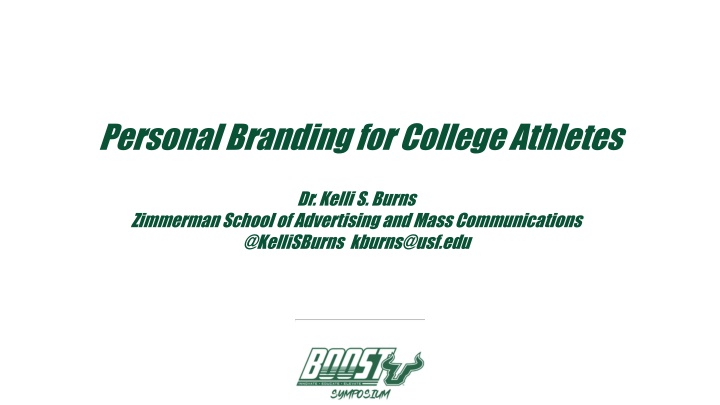
Ultimate Guide to Personal Branding for College Athletes: Strategies and Tips
Learn how college athletes can enhance their personal brand through social media promotions, affiliate marketing, and brand partnerships. Discover valuable insights on defining values, social media etiquette, content strategies, and more to maximize engagement and opportunities.
Download Presentation

Please find below an Image/Link to download the presentation.
The content on the website is provided AS IS for your information and personal use only. It may not be sold, licensed, or shared on other websites without obtaining consent from the author. If you encounter any issues during the download, it is possible that the publisher has removed the file from their server.
You are allowed to download the files provided on this website for personal or commercial use, subject to the condition that they are used lawfully. All files are the property of their respective owners.
The content on the website is provided AS IS for your information and personal use only. It may not be sold, licensed, or shared on other websites without obtaining consent from the author.
E N D
Presentation Transcript
Personal Branding for College Athletes Dr. Kelli S. Burns Zimmerman School of Advertising and Mass Communications @KelliSBurns kburns@usf.edu
Social media promotions are some of the easiest deals to execute right now. But you can also give lessons, make speeches, sign autographs, coach in clinics, attend grand openings, etc. Affiliate marketing (ClickBank) and selling merch (Spreadshirt) are other options.
Brands are looking for athletes who can help spread their brand story authentically to the athlete s audience.
What are your values? What are your passions/hobbies? How would you describe yourself? What is your backstory?
Basic Social Media Etiquette Think before you post. Everything you post is a representation of who you are. Retweets demonstrate support for a message so be careful whom you retweet. Don t hide behind a false identity on social media platforms. Stay away from controversy. Be positive, supportive of others, and grateful for opportunities.
Social Media Strategies Create a profile on all relevant social media platforms (IG, TikTok, Twitter, YouTube). Use the same handle on all. List school and sport in your bio. Include email address. Make sure accounts are public. Keep your DMs open. Share the URL of your INFLNCR profile. Your goal should be to build your following AND increase engagement. You don t need to have a huge following. Microinfluencers can also be valuable to brands. Ask question and look for other ways to get followers to engage. Then reply to their comments.
Social Media Content Followers are interested in behind-the-scenes information, tips for playing the sport, etc. Outside of your sport, how else would you define yourself? Gamer, dog lover, coffee drinker, pizza eater, yoga enthusiast, hiker, traveler, volunteer, family member, movie lover, etc. Post about that! What brands do you love? Create content around your love of those brands.
Social Media Content Define your niche. (Recruiting, memes, behind the scenes, Big Boy Probs) Case Study on Jon Seaton: An FCS Player Earning $10k per Month! (collegeathleteinsight.com) Create quality content. Post regularly.
Social Media Analytics On IG, set up or switch to a business account to view Insights. Check out Audience: Where do they live? What age? What gender? Check out Content: Which posts have performed the best? On Twitter, use a computer to view analytics (under More on the left then Analytics) Check out Tweets, and look at top tweets, impressions, engagement, and engagement rate. TikTok Understanding your analytics - Creator Portal | TikTok
Social Media Disclosures The FTC requires brands to inform influencers (including athletes) to disclose paid content. Make sure to follow the rules of the platform. For example, on IG, you will use the #ad hashtag. Avoid partnerships where the brand is discouraging following these guidelines. Only accept deals with brands you can honestly recommend. Don t make untrue claims about what the product does. (Helped me build muscle, lose weight, etc.)
Promotional Media Kit Create a one-page flyer about yourself to send to potential sponsors. You could also set up a website easily on Wix, Squarespace, Wordpress, etc. with the same information. Include the following: Photo Contact information Sport/school/position information, stats Bio Social media platforms, followers, engagement Best examples of posts
Connecting with Brands In addition to using INFLNCR, you could approach brands yourself. Follow brands you love on social and engage with them. Follow local business owners and engage with them. Approach via DMs. Explain how your followers are similar to the market they are also trying to reach. You could even do a mini-survey of your followers so you have some data when you pitch.
Working with Local Companies A local business may not have experience in hiring influencers, such as athletes. Both sides are unsure how to price social media posts. Instagram Influencer Pricing: How to Determine Influencer Rates in 2021 (hootsuite.com) Influencer Rates: How Much do Influencers Really Cost in 2022? (Influencermarketinghub.com) Consider pay per post as well as a commission through affiliate marketing (if appropriate).
Q&A Dr. Kelli S. Burns Zimmerman School of Advertising and Mass Communications @KelliSBurns kburns@usf.edu
